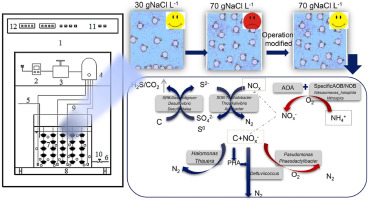当前位置:
X-MOL 学术
›
Water Res.
›
论文详情
Our official English website, www.x-mol.net, welcomes your
feedback! (Note: you will need to create a separate account there.)
Efficient nitrogen removal in a modified sequencing batch biofilm reactor treating hypersaline mustard tuber wastewater: The potential multiple pathways and key microorganisms.
Water Research ( IF 11.4 ) Pub Date : 2020-03-26 , DOI: 10.1016/j.watres.2020.115734 Jiale Wang 1 , Jian Zhou 2 , Yingmu Wang 2 , Yuhui Wen 2 , Lei He 2 , Qiang He 2
Water Research ( IF 11.4 ) Pub Date : 2020-03-26 , DOI: 10.1016/j.watres.2020.115734 Jiale Wang 1 , Jian Zhou 2 , Yingmu Wang 2 , Yuhui Wen 2 , Lei He 2 , Qiang He 2
Affiliation

|
This study first compared the efficiencies and mechanisms of the nitrogen removal in an aerobic sequencing batch biofilm reactor (SBBR) treating mustard tuber wastewater from high salt (30 gNaCl L-1) to ultra-high salt (70 gNaCl L-1). High-efficiency maintaining of nitrification was observed. Despite of high BOD5/TN (5.5-9), distinct denitrification decline for lack of carbon in response to salt stress was observed. Considering the high concentrations of sulfate in mustard wastewater, and the existence of sulfur-reducing bacteria (SRB) and sulfur-driven denitrifiers (DNSOB) in the aerobic SBBR, sulfate reduction-sulfur autotrophic denitrification process is a feasible idea to solve this problem. By modified to intermittent aeration mode, sulfur cycle was developed in SBBR. The average removal efficiency of COD, TN reached 85.20% and 98.56%, respectively. By batch activity tests and microbial community analysis, ammonia oxidation activity by ammonia-oxidizing archaea (AOA) was observed, and high abundance of AOA (Arch-amoA/AOB amoA: 2.38 × 102) together with ammonia-oxidizing bacteria (AOB) of Nitrosomonas_halophila (1.23%) ensured the high efficient nitrification. After running mode change, specific sulfur-driven NO3--N reduction rate increased and the abundance of dominant SRB and DNSOB rose from 3.95% to 10.79% and 2.22% to 9.95%, respectively. The sulfate-reducing process during anaerobic phase provided electron donors for subsequent autotrophic denitrification, making outlet NO3--N concentrations reduced from 18.26 mg L-1 to 1.93 mg L-1. The sulfur activity batch test showed that 73.80%∼80.92% of sulfate were circulation utilized, and rest of them conversed to the gaseous H2S and S0. In addition to DNSOB, anoxic denitrifier of Halomonas (22.91%), aerobic denitrifier of Phaeodactylibacter (2.75%) and endogenous denitrifier of Defluviicoccus (3.18%) were also dominant heterotrophic bacteria (all halophilic or halotolerant) in the intermittent aeration SBBR. Batch activity tests and periodic laws have also verified the existence of corresponding denitrification pathways. This study shows that the enrichment of special halophilic functional bacteria with multiple nitrogen removal pathways is a good idea for the efficient treatment of high-concentrated hypersaline industrial wastewater.
中文翻译:

在改良的测序生物膜反应器中处理高盐芥菜块茎废水的有效脱氮:潜在的多种途径和关键微生物。
这项研究首先比较了好氧定序分批生物膜反应器(SBBR)中从高盐(30 gNaCl L-1)到超高盐(70 gNaCl L-1)处理芥菜块茎废水中脱氮的效率和机理。观察到高效维持硝化作用。尽管BOD5 / TN(5.5-9)高,但由于盐分胁迫,由于缺乏碳,反硝化作用明显下降。考虑到芥菜废水中硫酸盐的高浓度以及好氧SBBR中存在降硫细菌(SRB)和硫驱动反硝化剂(DNSOB),硫酸盐还原-硫自养反硝化工艺是解决该问题的可行思路。通过修改为间歇曝气模式,在SBBR中开发了硫循环。COD,TN的平均去除率分别达到85.20%和98.56%,分别。通过分批活性测试和微生物群落分析,观察到氨氧化古细菌(AOA)产生的氨氧化活性,并且高丰度的AOA(Arch-amoA / AOB amoA:2.38×102)和氨氧化细菌(AOB)亚硝酸盐单胞菌(1.23%)确保了高效硝化作用。改变运行模式后,特定的硫驱动的NO3--N还原率增加,占主导地位的SRB和DNSOB的丰度分别从3.95%增加到10.79%,从2.22%增加到9.95%。厌氧阶段的硫酸盐还原过程为随后的自养反硝化提供了电子供体,使出口NO3--N浓度从18.26 mg L-1降至1.93 mg L-1。硫活度分批试验表明,循环利用了73.80%〜80.92%的硫酸盐,其余的则转化为气态的H2S和SO。除DNSOB之外,间歇曝气SBBR中卤代单氧菌的反硝化除菌剂(22.91%),好氧性拟杆菌属的反硝化剂(2.75%)和脱氧球菌的内源性反硝化菌(3.18%)也是主要的异养细菌(均为嗜盐或卤代厌氧菌)。批处理活动测试和周期性规律也验证了相应反硝化途径的存在。这项研究表明,通过多种脱氮途径富集特殊的嗜盐功能性细菌是有效处理高浓度高盐度工业废水的好主意。在间歇曝气SBBR中,占优势的异养细菌(全部为嗜盐或卤代菌)也占18%。批处理活动测试和周期性规律也验证了相应反硝化途径的存在。这项研究表明,通过多种脱氮途径富集特殊的嗜盐功能性细菌是有效处理高浓度高盐度工业废水的好主意。在间歇曝气SBBR中,占优势的异养细菌(全部为嗜盐或卤代菌)也占18%。批处理活动测试和周期性规律也验证了相应反硝化途径的存在。这项研究表明,通过多种脱氮途径富集特殊的嗜盐功能性细菌是有效处理高浓度高盐度工业废水的好主意。
更新日期:2020-03-27
中文翻译:

在改良的测序生物膜反应器中处理高盐芥菜块茎废水的有效脱氮:潜在的多种途径和关键微生物。
这项研究首先比较了好氧定序分批生物膜反应器(SBBR)中从高盐(30 gNaCl L-1)到超高盐(70 gNaCl L-1)处理芥菜块茎废水中脱氮的效率和机理。观察到高效维持硝化作用。尽管BOD5 / TN(5.5-9)高,但由于盐分胁迫,由于缺乏碳,反硝化作用明显下降。考虑到芥菜废水中硫酸盐的高浓度以及好氧SBBR中存在降硫细菌(SRB)和硫驱动反硝化剂(DNSOB),硫酸盐还原-硫自养反硝化工艺是解决该问题的可行思路。通过修改为间歇曝气模式,在SBBR中开发了硫循环。COD,TN的平均去除率分别达到85.20%和98.56%,分别。通过分批活性测试和微生物群落分析,观察到氨氧化古细菌(AOA)产生的氨氧化活性,并且高丰度的AOA(Arch-amoA / AOB amoA:2.38×102)和氨氧化细菌(AOB)亚硝酸盐单胞菌(1.23%)确保了高效硝化作用。改变运行模式后,特定的硫驱动的NO3--N还原率增加,占主导地位的SRB和DNSOB的丰度分别从3.95%增加到10.79%,从2.22%增加到9.95%。厌氧阶段的硫酸盐还原过程为随后的自养反硝化提供了电子供体,使出口NO3--N浓度从18.26 mg L-1降至1.93 mg L-1。硫活度分批试验表明,循环利用了73.80%〜80.92%的硫酸盐,其余的则转化为气态的H2S和SO。除DNSOB之外,间歇曝气SBBR中卤代单氧菌的反硝化除菌剂(22.91%),好氧性拟杆菌属的反硝化剂(2.75%)和脱氧球菌的内源性反硝化菌(3.18%)也是主要的异养细菌(均为嗜盐或卤代厌氧菌)。批处理活动测试和周期性规律也验证了相应反硝化途径的存在。这项研究表明,通过多种脱氮途径富集特殊的嗜盐功能性细菌是有效处理高浓度高盐度工业废水的好主意。在间歇曝气SBBR中,占优势的异养细菌(全部为嗜盐或卤代菌)也占18%。批处理活动测试和周期性规律也验证了相应反硝化途径的存在。这项研究表明,通过多种脱氮途径富集特殊的嗜盐功能性细菌是有效处理高浓度高盐度工业废水的好主意。在间歇曝气SBBR中,占优势的异养细菌(全部为嗜盐或卤代菌)也占18%。批处理活动测试和周期性规律也验证了相应反硝化途径的存在。这项研究表明,通过多种脱氮途径富集特殊的嗜盐功能性细菌是有效处理高浓度高盐度工业废水的好主意。











































 京公网安备 11010802027423号
京公网安备 11010802027423号